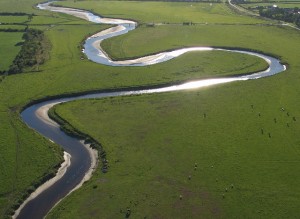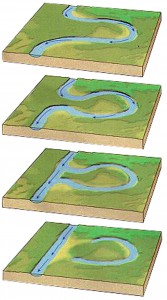Process
The unpredictability of a meandering river can be something very beautiful in the landscape, but it can also be seen as something that has the potential to create serious problems when it comes to local settlements and river crossings. A meander is formed when the sediment from the outer bank (concave bank) of the stream or river is eroded away by the moving water in these systems. The sediment that is carried away is deposited on the inner bank (convex bank), resulting in a snaking pattern.
This pattern can be seen as the water moves laterally across its down-valley axis (floodplain). Oxbow lakes are formed when these meanders are cut off from the main stem of the river. Specifically, oxbow lakes are formed when two concave banks have eroded away the sediment so much that they are immediately adjacent to each other. Once the two banks have finally been cut through, a newer, straighter channel is created and the abandoned meander loop is formed. An oxbow lake is formed when there has been enough deposition of the sediment at each end of the abandoned loop that it seals off the loop from the river.
We envision our process as an animation that illustrates the movement of the sediments across the river. By varying the scale at which we look at this movement, we will be able to gain a full understanding of the affect of this sediment deposition across the larger landscape.
*This is an interesting video that goes along with the post Brad made about the meandering river study at UC Berkeley.



